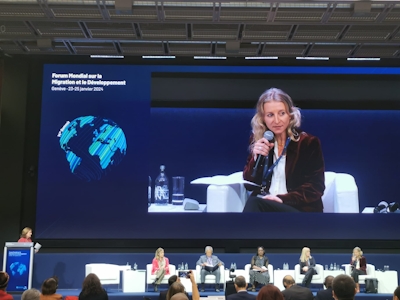
Event
23 January 2024
-Geneva, Switzerland
IDMC at the 14th Global Forum on Migration and Development Summit
IDMC made high-level and detailed contributions to the 14th Summit of the Global Forum on Migration & Development in Geneva, 23-25 January 2024.
The government of France, as Chair of the GFMD 2022-2023, has made the impact of climate change on human mobility a central theme of its chairmanship. Director Alexandra Bilak spoke on the high-level panel on Migration and Climate Change on 23 January, and in the side-event Supporting Actions to Promote Solutions to Internal Displacement in a Changing Climate: A Conversation with Development Actors, co-organised on 24 January by IDMC with the United Nations Development Programme, Asian Development Bank, and the Government of Fiji.
For the high-level panel, Ms Bilak offered prepared remarks (below) and offered insights as part of the discussion. The side event engaged in an interactive conversation with different stakeholders to share their perspectives and experiences to address internal displacement in the context of climate change and disasters. The panel focused on efforts to develop evidence-based interventions and discussed the types of data and tools needed to measure the development impact of internal displacement, design and implement development-oriented solutions, and monitor progress or pathways toward such solutions.
Ambassador Luke Daunivalu, Permanent Representative of Fiji to the United Nations Office and other International Organisations in Geneva opened the side event. Ms. Bilak then moderated the panel discussion composed of Henny Ngu, Policy Advisor on Forced Displacement, United Nations Development Programme, Samuel Tumiwa, Representative, Asia Development Bank North American Representative Office, Mary Namono, Counselor, Uganda Permanent Mission to the UN and other International Organisations in Geneva, and Atle Solberg, Head of the Platform on Disaster Displacement Secretariat.
IDMC Director Alexandra Bilak's remarks at the 14th GFMD Summit
High Level Panel on Migration and Climate Change
The reality and challenges of climate induced mobility today
CICG, Geneva, Room A
23 January 2024 - 11:45-12:45
Ms Bilak offered prepared remarks:
Merci Caroline.
Mesdames et Messieurs les ministres, ambassadeurs et chefs de délégation, Chers panélistes et participants, C’est un grand plaisir de prendre la parole aujourd’hui et je voudrais remercier le gouvernement francais pour son invitation à partager quelques réflexions avec vous.
Je vais souligner trois points qui me semblent essentiels pour comprendre les principaux défis qui entourent la question qui nous réunit ici aujourd’hui. Si vous me le permettez, je vais maintenant poursuivre en anglais.
My first point, is that climate and disaster displacement is a global phenomenon that affects every country in the world, though unevenly and with different consequences across contexts. As you can see from this map, millions of people are becoming displaced from their homes as a result of a variety of hazards. The blue bubbles show the number of disaster displacements recorded in 2022 alone, with a total of 32.6 million caused mostly by weather-related hazards like floods, storms and drought.
For the past 15 years, we've reported on average 25 million such displacements each year. And we know that these numbers are under-estimates, as they don't include people leaving their homes as a result of slow onset events like sea level rise or desertification. We are still compiling the figures for 2023 that will be published in our Global Report on 14th of May. Last year in the Horn of Africa, we saw how floods caused some of the highest disaster displacements ever recorded in the region. And this was following a prolonged drought that had already forced millions from their homes in previous years.
Hundreds of thousands of people were also displaced last year in Canada following widespread wildfires that occurred during one of the country's hottest summers this past century. So while low and middle-income countries tend to report the highest numbers of disaster displacements, high-income countries are not spared from this phenomenon.
My second point is that while climate change is making weather-related events more frequent and more intense, it is only one factor contributing to displacement. Indeed a disaster will not have the same impact on people, communities and countries. Its severity, and the severity of the displacement it causes, depends on a number of factors. Crowded urban areas, poor infrastructure, lack of preparedness and response, and people's own coping capacities, also play a key role.
If you look at the global map again, you can also see that many countries are now covered in blue and orange bubbles, representing disaster and conflict displacement. This shows that in some places, people already displaced by a conflict can be displaced again by a flood or a storm. It is the combination of all these factors that ultimately determines the severity displacement, the risk of it becoming protracted, and who is likely to be disproportionately affected.
My last point, is that displacement is not inevitable. Looking at these connections, there is a clear case to be made for addressing it as an integral part of sustainable development, climate action, DRR, but also humanitarian response and peacebuilding. The evidence out there shows that building homes in safer areas, setting up early warning systems, and responding to the long-term needs of people displaced, can help reduce the scale, and ultimately the risk, of future displacement.
For this, we need a solid and comprehensive global baseline that can provide an accurate measure of the scale of displacement today, and that can help track progress and setbacks systematically across different countries and investment scenarios. Better data at global, national and sub-national level will continue to be a key priority moving forward, as much as equipping governments with the tools and the systems they need to monitor, report on and make choices for the future.
I know there is much experience in this room today and I look forward to hearing the interventions of my fellow panelists. Thank you again for your invitation and your attention.